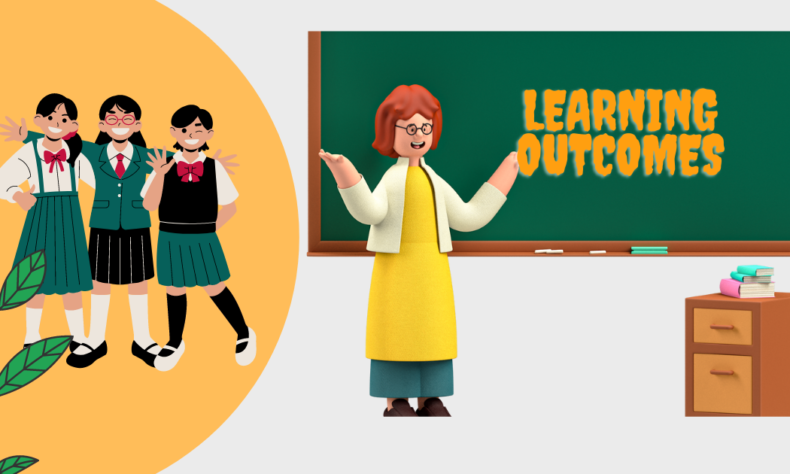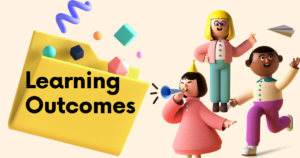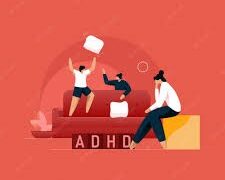
Introduction:
Napoleon Bonaparte in the 18th Century said that, “Give me an educated mother, I shall promise you the birth of a civilized, educated nation” . Thinking anything without education in this context is often impossible in today’s era. To dominate anything, we must first learn it well. All work depends on learning results. Depending on this, all tasks are implemented. So we should before doing any work, to gain knowledge and learn well about work.

Learning Outcomes are a description by which students describe the skills or knowledge they have acquired at the end of a particular class, course, assignment, or program and helps students understand why those skills and those knowledge will be useful to them.
Learning outcomes also play a key role in assessment, they Concentrate on the subject of skills and knowledge potential application, so that It helps them to connect with education in different contexts and helps in assessment. Emphasizes the application of good learning outcomes and the utilization of knowledge. Explains how students can use learning outcomes more broadly in a classroom context.
Feature of Learning Outcomes
- What will students gain from learning activities?
- Specifies what the students can do after the learning program is finished.
- It shows what has been achieved, what happened to the students due to their participation in activities.
- Describes a wide range of behavior, knowledge and expertise that creates the foundation of learning.
- Students are able to identify situations where companies may apply and describe proper steps in their response.
- Students can understand and apply practices to solve basic conflicts at work.
- Students are able to manage software and explain the functions they are using.
- Students can remove and replace the elements of each machine properly, explain what they are doing and why.
- Students can show how they use the organization’s strategy with effective steps.
5 types of learning outcomes
- Intellectual skills
Students use the results of teaching intellectual skills to convey ideas, rules or methods about different subjects. The results of this type of education explain how all the work can be done.
- Cognitive strategy
This type of learning results in students using personal strategies for thinking, organizing, learning and behavioral development.
- Verbal information
When a student is able to say for sure what he has learned from an organized
knowledge is the result of Verbal information learning.
- Motor skills
Acquiring fluidity, physical ability to perform activities, smoothing through practice or proper duration are related to this category.
- Attitude
Attitude is an internal condition that is reflected in the behavior of students. Student reactions to people or situations can be shown although it is quite difficult to measure.
Developing Learning Outcomes:
Learning Outcomes is a user-friendly statement that tells students what they will be able to do at the end of the term. These are often measurable and observable. They can be a valuable component of any class as they sharpen students’ focus on learning, although learning outcomes are usually described in the light of program-based assessment.
Learning outcomes:
- Make it clear that your students will be able to do at the beginning of the course what they did not do at the end.
- Instead of focusing on student instructional methods or course content, focus on student talent, creativity, or performance.
- Everyone should be student-centered and not teacher-centered.
- Be clear about course expectations to your students.
Writing Effective Learning Outcomes:
Selection of Active, Measurable Verbs are the key to writing effective learning outcomes – the tasks you want students to do at the end of your class. There are some words that are hard to measure, such as knowing, understanding, or appreciating, and they rarely get the job of higher thinking that many of us really want to see in our students. Also consider more specific words instead, which lead to more difficult merit work. To enable students…
- Think
- Explain
- To describe
- Compare
- Differentiate
- Implementation
- Judgment
- Create
Next, consider how you can measure whether students have met those results. What kind of assignment or activity will prove that they can meet these results?
Using Learning Outcomes within Your Class:
It clearly defines well-written learning outcomes to guide students across the course of what kind of results you expect from students at the end of a semester. Try to put the results in a special place in your syllabus and you express good ideas about them to the students and talk frequently about how they can reach their specific results clearly. Find opportunities to concentrate on the results of students across the whole course and determine regular goals to reflect their progress to reach their specific goals. So these tools are most effective in your class when used actively as a way to show students the way to learn and when you can be familiar with results in learning as part of an evaluation plan.
Consider ways to design your course because the results of learning results for your class may supply a useful structure. The results of this education on the basis of the above suggestions may be used as a primary point, to design the rest of our courses, adjust the results to test and assignment, then in class activities that prepare students with the skills needed to complete these tasks.
Learning Outcomes of Students:
- The results of learning should be specific and well-defined
- The results of learning should be realistic.
- Education results should depend on active actions in the future.
- The results of education should be made in terms of programs instead of the program specified by the program.
- Must have a sufficient number of learning results.
- The results of education should be compatible with the program’s curriculum.
- Learning results should be easy and not compound.
- Learning results should focus on learning products and are not a learning process.
Group Exercise to Create Learning Outcomes:
Complete this practice in a group of faculty members in your program. At the end of this process, it should be able to make 3-5 learning results for your program evaluation plans and make them clear.
Step 1
Start with a discussion that graduates from your program “perfect student” key should be able to represent, or produce.
Step 2
Manage a panel discussion about your learning results using convenience. Combine all the criteria in one list and rank each member anonymously as a little, somewhat, or important. Discuss results with your faculty and repeat the process until it is repeatedly oriented.
Step 3
Maps learning results in the program courses to ensure educational consistency using the matrix on the following page. It will ensure that there are adequate opportunities for each student of your program.
Step 4
List the final set of your learning results and change the last using the faculty checklist.
The value of effective learning outcomes statements:
An effective set of statements of learning results point to you and both of your students and directs:
For teaching staff: informs:
- The content of education
- Teaching techniques do you use
- You have set that kind of education activities / tasks for your students
- Proper evaluation work
- Course evaluation
For students: The set of learning results provide them with:
- Help them to prepare for a solid structure and their assessment to show their teaching way.
- A point of precision with graduate qualities of the course and / or university (such as generic) level graduate qualities.
From this, the result of effective education should be:
- Mark important education requirements (learning ‘content’ – knowledge range and type, skill and required value).
- Use clear language that is understandable by students and other potential clients.
- Link to Generic or Course Graduate Attribute.
- Achievable and evaluable.
- Related to a clear statement of achievement (such as understanding level required).
Example of Learning Outcomes:
A learning result is only needed when it is measurable. The learner’s learning behavior should include proper evaluation methods and specific criteria, which show success. The results of the written education are mentioned below:
examples are well-written learning outcomes:
- Students will be able to identify which of all types of conflict management should be applied.
- Students will be able to use all training materials effectively and use the company’s LMS to complete.
- Students will understand how to explain marketing data and use it to create graphs.
- Students will understand how companies-prescribed SEO practices are used when writing copies.
- Students can use the company’s guidelines properly to create a case study.
- Students will be able to manage autoclaves properly and clean.
examples are poorly written learning outcomes:
- Students will understand conflict management.
- Students will know how to use the company’s LMS.
- Students will appreciate how to use marketing data.
- Students will know about the company’s SEO practice.
- Students will understand what goes in a case study.
- Students will know about Autoclave.
Conclusion:
An important part of creating a training program is to create functional and clear learning outcomes. The results of a well-written education show how students can apply their knowledge in a real world context instead of accepting new information. Verbs are one of the most essential elements in learning outcomes that describe an observable verb, a description of what conditions students will be able to reach under what conditions and what will work. The result of education helps to enhance it clearly.





